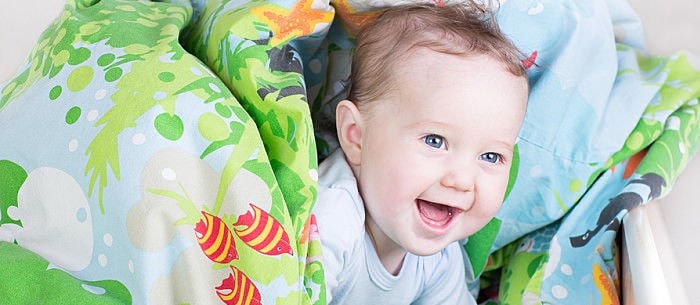When your baby was first born, she didn’t do much besides sleep and eat. But now that she’s entering month 4, she’s really starting to get a feel for the world — and you’re excited to watch her growth and development.
According to Dr. Nadja Reilly, associate director of the Freedman Center for Child & Family Development, “Month 4 is a very big month for babies because there is a lot going on.” Your baby’s 4-month-old development is absolutely amazing. Not only is your little one absorbing more information and becoming more in tune with her world, she’s also interacting and playing with you on a much greater scale.
And read
our guide to developmental milestones for kids
.
Cognitive Milestones to Expect
According to the American Academy of Pediatrics, one of the most important concepts that your baby will learn at this age is cause and effect. Around 5 months, your baby will start to notice that the things she does have consequences — for example, “your baby starts to realize that if she drops her rattle, Mommy or Daddy will pick it up — and she might even think that’s pretty funny,” says Dr. Ashanti Woods, an attending pediatrician at the Mercy Medical Center in Baltimore.
Around 5 months of age, your baby will also begin to realize that even though she can’t see an object, it’s still there — a concept known as object permanence. She’s starting to remember that you’re the one who always cares for her needs and that her teddy bear is still there, even if it’s hidden under a blanket. At this age, “your baby’s brain is constantly developing and her memory is getting sharper,” says Dr. Woods.
Closely related to the development of object permanence, babies may start to exhibit stranger anxiety around 6 or 7 months. As your baby starts to understand that you still exist even when she can’t see you, she doesn’t want to be with anyone else but you. This can be tricky to deal with but not impossible. According to Dr. Reilly, she’ll also start to differentiate more between family members and show preference toward different caregivers.
Wondering how to deal with stranger anxiety? Read Child Care Challenges: Separation Anxiety.
Your baby will also begin to respond to her own name, as well as to “No.” By 7 months, she will be able to respond to sound by making sound herself. She might also be babbling a lot at you.
Tips for Parents
You can help support your little one through her 4-month-old development by initiating back-and-forth interactions with her. Babies love to play peekaboo, which helps develop their grasp of object permanence. Cover and uncover your face with your hands, or place your baby in front of a mirror and cover and uncover her face with your hands. Use a blanket to hide her favorite toy and then lift the blanket to reveal the toy. Babies also enjoy responsive games like pat-a-cake or just sticking your tongue out and having her imitate you. These games help your baby develop the idea of, “If I do this, then this happens,” according to Dr. Reilly.
Additionally, the attachment you’ve been forming with your little one since birth has been laying the foundation for her cognitive development. “A lot of growth and development happens in relation to strong attachment,” says Dr. Reilly. Pay attention to your baby’s cues, and be responsive. If your baby seems interested in playing, go for it, but if she starts showing signs that she’s done, like turning her head away or becoming fussy, then back off. “Babies need a nice balance of playtime and downtime,” says Dr. Reilly.
Remember, all babies reach these milestones at their own pace. Always speak with your pediatrician if you have any questions about your baby’s growth and development.
For more, check out this Overview of Milestones from 4 to 7 months.
Rebecca Desfosse is a freelance writer specializing in parenting and family topics.
* This article is for general informational purposes only. It is not intended nor implied to be providing medical advice and is not a substitute for such advice. The reader should always consult a health care provider concerning any medical condition or treatment plan. Neither Care.com nor the author assumes any responsibility or liability with respect to use of any information contained herein.





